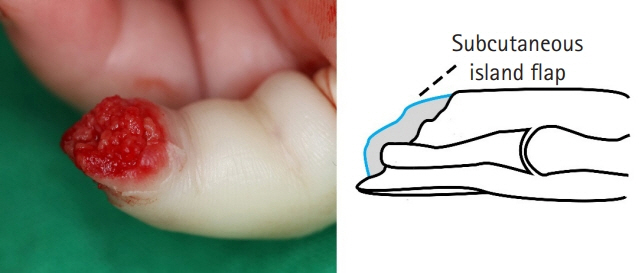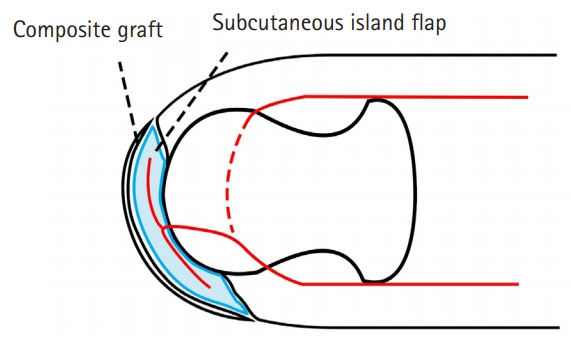Arch Hand Microsurg.
2020 Dec;25(4):282-286. 10.12790/ahm.20.0047.
Fingertip Reconstruction with Subcutaneous Island Flap and Composite Graft: A Case Report
- Affiliations
-
- 1Department of Plastic and Reconstructive Surgery, Gwangmyeong Sungae Hospital, Gwangmyeong, Korea
- KMID: 2508941
- DOI: http://doi.org/10.12790/ahm.20.0047
Abstract
- Reconstruction of amputated fingertips is extremely challenging when the amputee is very small and severely crushed. Moreover, there are not many options if distal phalanx is exposed due to defects of soft tissue. We report a case of successful fingertip reconstruction in a 10-month-old girl using a subcutaneous island flap with a composite graft. Her fingertip of the right little finger was amputated stuck by the air purifier. Some soft tissue was lost from the stump and the bone was exposed. There was a very small amputee, and soft tissue was extremely little inside. Replantation was not possible because of the soft tissue defect. The composite graft was inadequate due to the exposure of distal phalanx and defect of soft tissue. Soft tissue island flap based terminal branch of the digital artery was transposed to cover the distal phalanx. After then, the amputee was grafted over the flap. After debridement, most of the soft tissue survived and 0.2×0.2 cm of skin defect was found, which was healed through secondary intention.
Keyword
Figure
Reference
-
1. Kusuhara H, Ichinohashi K, Sueyoshi Y, Tabata Y, Isogai N. Reconstruction of severely crushed fingertip amputations with basic fibroblast growth factor slow release system. Plast Reconstr Surg Glob Open. 2017; 5:e1384.
Article2. Bickel KD, Dosanjh A. Fingertip reconstruction. J Hand Surg Am. 2008; 33:1417–9.
Article3. Alper N, Sood A, Granick MS. Composite graft repair for distal fingertip amputation. Eplasty. 2013; 13:ic32.4. Venkatramani H, Sabapathy SR. Fingertip replantation: technical considerations and outcome analysis of 24 consecutive fingertip replantations. Indian J Plast Surg. 2011; 44:237–45.
Article5. Wang K, Sears ED, Shauver MJ, Chung KC. A systematic review of outcomes of revision amputation treatment for fingertip amputations. Hand (N Y). 2013; 8:139–45.
Article6. Douglas B. Successful replacement of completely avulsed portions of fingers as composite grafts. Plast Reconstr Surg Transplant Bull. 1959; 23:213–25.
Article7. Son D, Chu H, Yeo H, Kim J, Han K. Finger tip composite grafting managed with moist-exposed dressing. J Korean Soc Surg Hand. 2012; 17:9–15.8. Ryu DH, Roh SY, Kim JS, Lee DC, Lee KJ. Multiple venous anastomoses decrease the need for intensive postoperative management in tamai zone I replantations. Arch Plast Surg. 2018; 45:58–61.
Article9. Nam YS, Jun YJ, Kim IB, Cho SH, Han HH. Anatomical study of the fingertip artery in Tamai Zone I: clinical significance in fingertip replantation. J Reconstr Microsurg. 2017; 33:45–8.
Article10. Strauch B, de Moura W. Arterial system of the fingers. J Hand Surg Am. 1990; 15:148–54.
Article
- Full Text Links
- Actions
-
Cited
- CITED
-
- Close
- Share
- Similar articles
-
- Fingertip reconstruction with a subcutaneous flap and composite graft composed of nail bed and volar pulp skin
- Reconstruction of Facial Defects with Subcutaneous Island Pedicle Flap
- A Case of Reconstruction of Upper Cheek with Subcutaneous Island Pedicle Flap
- Early Flap Detachment of Heterodigital Island Flaps
- RECONSTRUCTION OF A "THROUGH-AND-THROUGH" DEFECT OF BUCCAL CHEEK WITH BILOBULAR PECTORALIS MAJOR MYOCUTANEOUS ISLAND FLAP: REPORT OF A CASE & COMPARISON WITH A CONVENTIONAL PECTORALIS MAJOR MYOCUTANEOUS FLAP







